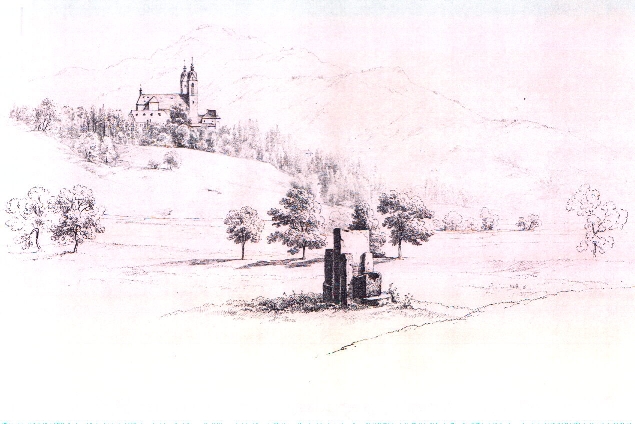Duke's Chair on:
[Wikipedia]
[Google]
[Amazon]
The Duke's Chair, also known as the Duke's Seat (, or ), is a medieval stone seat dating from the ninth century and located at the Zollfeld plain near

 The Duke's Chair, made mainly of
The Duke's Chair, made mainly of
Maria Saal
Maria Saal () is a market town in the district of Klagenfurt-Land in the Austrian state of Carinthia. It is located in the east of the historic Zollfeld plain (''Gosposvetsko polje''), the wide valley of the Glan River. The municipality includes ...
, north of Klagenfurt in the Austria
Austria, formally the Republic of Austria, is a landlocked country in Central Europe, lying in the Eastern Alps. It is a federation of nine Federal states of Austria, states, of which the capital Vienna is the List of largest cities in Aust ...
n state of Carinthia
Carinthia ( ; ; ) is the southernmost and least densely populated States of Austria, Austrian state, in the Eastern Alps, and is noted for its mountains and lakes. The Lake Wolayer is a mountain lake on the Carinthian side of the Carnic Main ...
.
History

 The Duke's Chair, made mainly of
The Duke's Chair, made mainly of Roman
Roman or Romans most often refers to:
*Rome, the capital city of Italy
*Ancient Rome, Roman civilization from 8th century BC to 5th century AD
*Roman people, the people of Roman civilization
*Epistle to the Romans, shortened to Romans, a letter w ...
gravestones from nearby Virunum
Claudium Virunum was a Roman Empire, Roman city in the province of Noricum, on today's Zollfeld in the Austrian State of Carinthia (state), Carinthia. Virunum may also have been the name of the older Celtic-Roman settlement on the hilltop of Magd ...
, actually consists of two stone seats, whose backrests are attached to each other. The larger seat, facing to the east, was reserved for the dukes, the other one, slightly older and facing to the west, for the counts palatine
A count palatine (Latin ''comes palatinus''), also count of the palace or palsgrave (from German language, German ''Pfalzgraf''), was originally an official attached to a royal or imperial palace or household and later a nobleman of a rank abo ...
of the ''Meinhardiner
The House of Gorizia, also called the Meinhardiner, were a comital, princely and ducal dynasty in the Holy Roman Empire. Named after Gorizia Castle in Gorizia (now in Italy, on the border with Slovenia), they were originally "advocates" (''Vo ...
'' dynasty.
Together with the Prince's Stone, it played an important role during the installation of the Dukes of Carinthia in a ceremony that may date back to the early medieval principality of Carantania. The chair was first mentioned as ''sedes Karinthani ducatus'' on the occasion of the installation of Duke Herman II of Spanheim in 1161. Here the newly installed duke had to swear an oath
Traditionally, an oath (from Old English, Anglo-Saxon ', also a plight) is a utterance, statement of fact or a promise taken by a Sacred, sacrality as a sign of Truth, verity. A common legal substitute for those who object to making sacred oaths ...
in German
German(s) may refer to:
* Germany, the country of the Germans and German things
**Germania (Roman era)
* Germans, citizens of Germany, people of German ancestry, or native speakers of the German language
** For citizenship in Germany, see also Ge ...
and received the homage of the estates. It was the last part of a series of rituals which consisted of the ducal installation on the Prince's Stone (performed in Slovene) and of a mass
Mass is an Intrinsic and extrinsic properties, intrinsic property of a physical body, body. It was traditionally believed to be related to the physical quantity, quantity of matter in a body, until the discovery of the atom and particle physi ...
, which was held at the church of Maria Saal.
The last installation took place in 1651, though the Duke, Ferdinand of Habsburg, the son of Emperor Ferdinand III, did not take part in person, but was represented by a personal deputy.
See also
* Prince's Stone * Carantania *March of Carinthia
March is the third month of the year in both the Julian and Gregorian calendars. Its length is 31 days. In the Northern Hemisphere, the meteorological beginning of spring occurs on the first day of March. The March equinox on the 20 or 21 ...
* Duchy of Carinthia
The Duchy of Carinthia (; ; ) was a duchy located in southern Austria and parts of northern Slovenia. It was separated from the Duchy of Bavaria in 976, and was the first newly created Imperial State after the original German stem duchies.
Car ...
References
Sources
* * {{coord, 46, 41, 27, N, 14, 20, 47, E, display=title, region:AT-2_type:landmark_source:dewiki Duchy of Carinthia Individual thrones Medieval history of Slovenia Political history of Slovenia